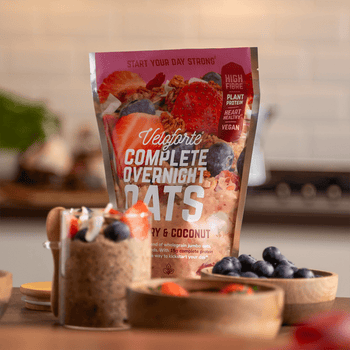Everyone will have experienced the discomfort of a muscle cramp at least once in their life. These involuntary contractions can strike suddenly, causing sharp pain and disrupting daily activities or workouts and often result from dehydration, electrolyte imbalances, or muscle fatigue. At Veloforte, we believe that it is important to understand why they happen, how to stop muscle cramps before they start and what to do if you cramp up - to help you achieve and maintain peak physical performance or simply avoid experiencing painful muscle cramps again. In this guide, we’ll explore practical tips to prevent and relieve cramps, from proper hydration and sports nutrition to effective stretching and muscle care techniques.

Understanding Muscle Cramps
Before we look at methods to prevent muscle cramps, it's important to understand exactly what muscle cramps are. Muscle cramps are sudden contractions of one or more muscles, often causing sharp pain and temporary immobility. Several factors cause them and muscle cramps can serve as an extremely painful inconvenience which, once onset, interrupts activity and can take a prolonged time to get rid of.
Muscle Cramps In Different Parts of The Body
Muscle cramps can occur in various parts of the body, each with unique causes and characteristics. Leg cramps are the most common type, often affecting the calves, thighs, or feet. These cramps frequently happen during exercise or at night and are usually caused by muscle fatigue, dehydration, or poor circulation.
Cramps in the hands and feet tend to result from repetitive movements, poor posture, or nerve compression. These smaller muscles are more prone to cramping when overused or strained.
Abdominal cramps, which feel like tightening or spasms and are often linked to digestive issues, muscle strain, or menstrual cramps in women. Meanwhile, back cramps usually arise from muscle strain, poor posture, or spinal problems and may cause a deeper, persistent ache or spasm. Understanding these differences helps target the right prevention and relief methods for each muscle group.
The Role of Hydration
Hydration is a crucial, yet overlooked, factor in preventing muscle cramps because water helps maintain the proper function of muscles and nerves. When your body is dehydrated, your muscles can become more prone to tightening and cramping. Drinking enough fluids before, during, and after physical activity ensures your muscles stay supple and reduces the risk of painful spasms. It’s important to listen to your body’s thirst signals and aim to drink water consistently throughout the day, especially in hot weather or during intense exercise, to prevent muscle cramps.
Importance of Electrolytes
Electrolytes are several vital minerals, such as sodium and potassium, which help with muscle functions, but most importantly, reduce cramping. These minerals help send electrical signals between nerves and muscles, allowing your muscles to contract and relax smoothly. However, when electrolyte levels become imbalanced, muscle cells can become overexcited or fail to relax properly, leading to painful cramps. Having a regular intake of electrolytes through a healthy diet or supplements, such as electrolyte powders, can help reduce cramping as well as optimise hydration, which, as we have mentioned, is also crucial. Foods such as bananas, leafy greens, nuts, and dairy are also excellent sources of electrolytes and can help keep your levels in check.

Stretching and Warm Up Exercises
Another method to reduce your chances of cramping is through stretching and warm-up exercises. Although many people look down on stretching, learning what to do before exercise and having a warm-up routine can be extremely beneficial, especially before engaging in exercises such as running or cycling. Warming up properly increases blood flow to the muscles, making them more flexible and less prone to sudden tightness or spasms. Dynamic stretches should be a part of your warm-up, as movements like leg swings or arm circles gently prepare your muscles for movement. Static stretches are also very useful post-exercise to help maintain muscle length and reduce tension. Regularly incorporating stretching and warm-ups into your routine improves muscle elasticity and coordination, lowering the risk of cramps during workouts or daily activities.
Part of your warm-up and exercise prep should include fueling your body with the right ingredients, and if you are looking for the best food to prepare you for long cycling trips, check out the Veloforte cycling nutrition section.
How To Stop Muscle Cramps Fast?
Prevention is very important; however, cramps can sometimes occur even with every precaution taken. Once they occur, stopping the cramp fast becomes the next priority. One of the fastest ways to relieve a muscle cramp is to stretch the affected muscle gently. For example, if you have a cramp in your calf, try pulling your toes toward your shin to lengthen the muscle. Along with stretching, massaging the cramped area helps increase blood flow and relax tight muscle fibres, easing the pain quickly. Using slow, gentle pressure can make a big difference in stopping the cramp faster.
Applying a warm compress to the cramped muscle can also help it relax by improving circulation and blood flow, while also encouraging muscle fibres to loosen, which often reduces cramping pain. Alternatively, some people find that by applying a cold pack, especially if the cramp is accompanied by soreness or inflammation, they can experience relief from the cramp. You can alternate between heat and cold to find what works best for your body.
Once the initial cramp subsides, gently moving or walking around can prevent the muscle from tightening up again. Focus on your hydration and electrolyte needs. Light activity encourages blood flow and keeps the muscles flexible. Avoid sudden or intense movements right after a cramp, but gentle mobility helps muscles return to normal and reduces the chance of another cramp.





